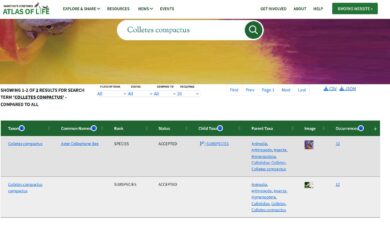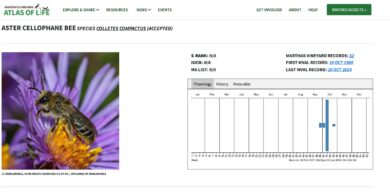MVAL Adds a Data Explorer
The Martha’s Vineyard Atlas of Life has added a powerful new tool to its website: an easy-to-use “data explorer” that searches a vastly expanded set of Martha’s Vineyard wildlife records. It provides easy access to historical as well as modern data and provides information on many species that have not yet made it into iNaturalist. Here’s a basic explanation of how it works and what it can do.
The search window on the MVAL homepage represents a Vineyard-optimized interface for searching the Global Biodiversity Information Facility (GBIF), an international consortium that collects worldwide biodiversity information. GBIF periodically sweeps in datasets that the MVAL was already using, such as eBird records and “research-grade” observations in iNaturalist. But it also contains records from many less accessible sources that have been “published” to GBIF: museum collection catalogs, checklists, historical survey results, species lists from scholarly articles, and the like.
The type and amount of information available of course varies depending on what taxonomic group you’re investigating; for many taxonomic groups, Vineyard information is still sparse or entirely lacking. But for many groups, the newly accessible data go far beyond what is available in iNaturalist, the platform the MVAL has mainly relied on in the past. For example, our Martha’s Vineyard iNaturalist project contains 132 confirmed, or “research grade,” bee observations of representing 84 species. But the magisterial study of Vineyard bees led by Paul Goldstein and John Ascher in 2010-2011 generated more than 14,500 precisely identified bee records representing more than 180 species – and most or all of the records from that study have been published to GBIF! So the data explorer allows a much more complete and detailed picture of Vineyard bees than iNaturalist alone could produce.
The new tool is remarkably easy to use: just type a taxon name (species, genus, family…) into the search window on the MVAL website homepage and click the “search” icon. The explorer, which recognizes both scientific names and established common names, searches for any Vineyard records in GBIF that meet the criterion you set. As an example, I entered the scientific name of one of my favorite bees, Colletes compactus:

In this case, the explorer found records for two taxa: the species Colletes compactus, with 32 Vineyard records available, and the subspecies Colletes compactus compactus, with 12 records available. Clicking on the taxon name takes you to a summary page for that taxon, with a photograph, a bar chart showing seasonality (in this case, we see that C. compactus is exclusively a late-season bee), and a summary of the available records:

Clicking on the number of Vineyard records in the upper right, in turn, takes you to an interactive map showing the individual records:

And clicking on an individual dot shows you the details of records associated with that dot. In this case, I clicked on that dot out at the Gay Head Cliffs, in Aquinnah near the Vineyard’s westernmost point. In this case, the dot captures three records, two from October 3, 2023, and one from October 10, 2022. These records happen to be based on iNaturalist observations. When you click on a record, the explorer shows you all the details of the observation, including all the photos uploaded into iNat by the original observer.

At each step, results may vary depending on what types of records are available for your search item, and whether they are associated with precise location coordinates. And of course the system can only work with the data that are available: information that has not been added to GBIF is not visible to the explorer. But for anyone interested in exploring the biodiversity of Martha’s Vineyard, the availability of this tool is major breakthrough in ease of use and comprehensiveness of data.
The data explorer was developed by our friends at the Vermont Center for Ecostudies for their Vermont Atlas of Life (VAL) project (the inspiration and model for the MVAL). Jason Loomis, Senior Software Developer at VAL, and our web guru, Gabe Halberg at Dadra Design, adapted the Vermont data explorer for MVAL use and installed it on our website with funding from the Betsy and Jesse Fink Family Foundation. Thanks one and all for providing this major upgrade!
The MVAL iNaturalist project remains a practical resource for exploring current and recent Vineyard observations, and uploading your photos and recordings to iNat is still the best way to add your sightings to the MV Atlas of Life.
Matt Pelikan is the director of the Martha’s Vineyard Atlas of Life project at BiodiversityWorks. He’s a naturalist, not a software engineer, but still thinks the new data explorer is really cool!

